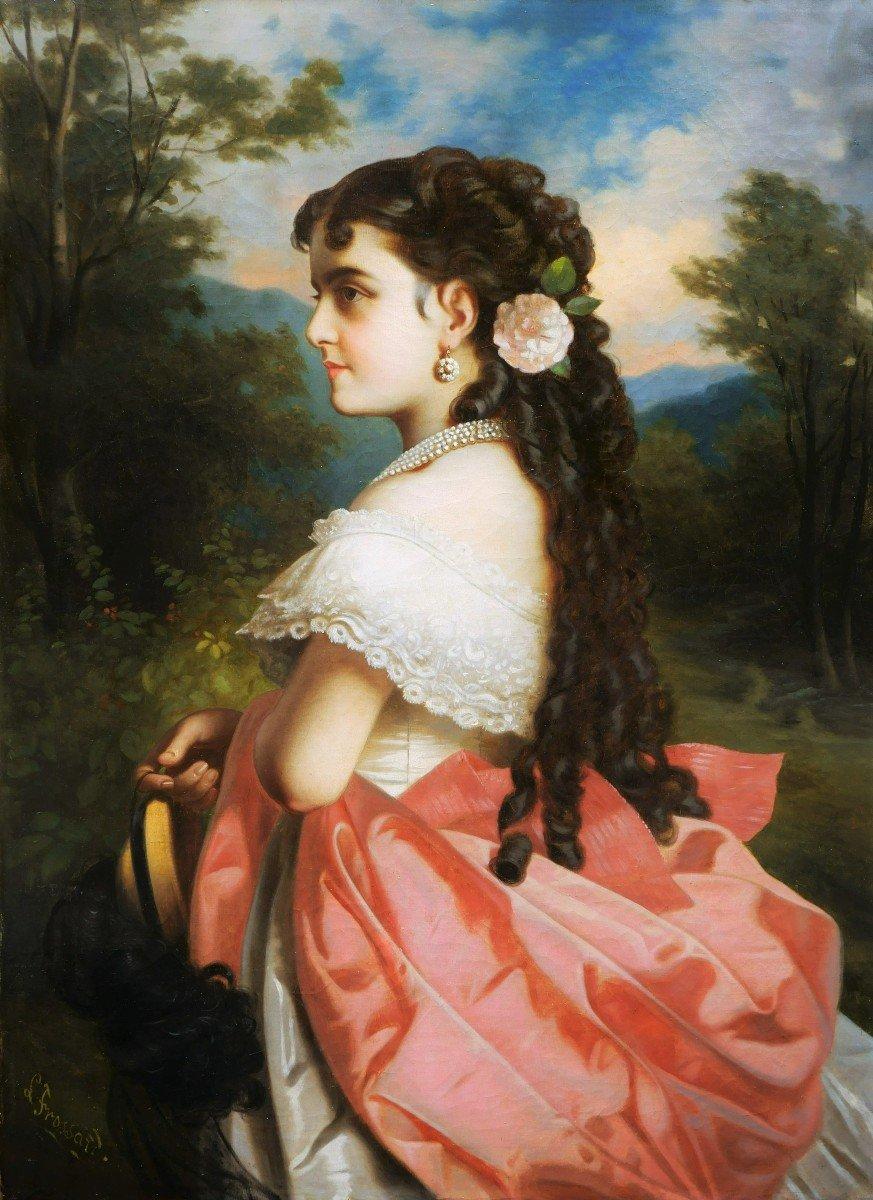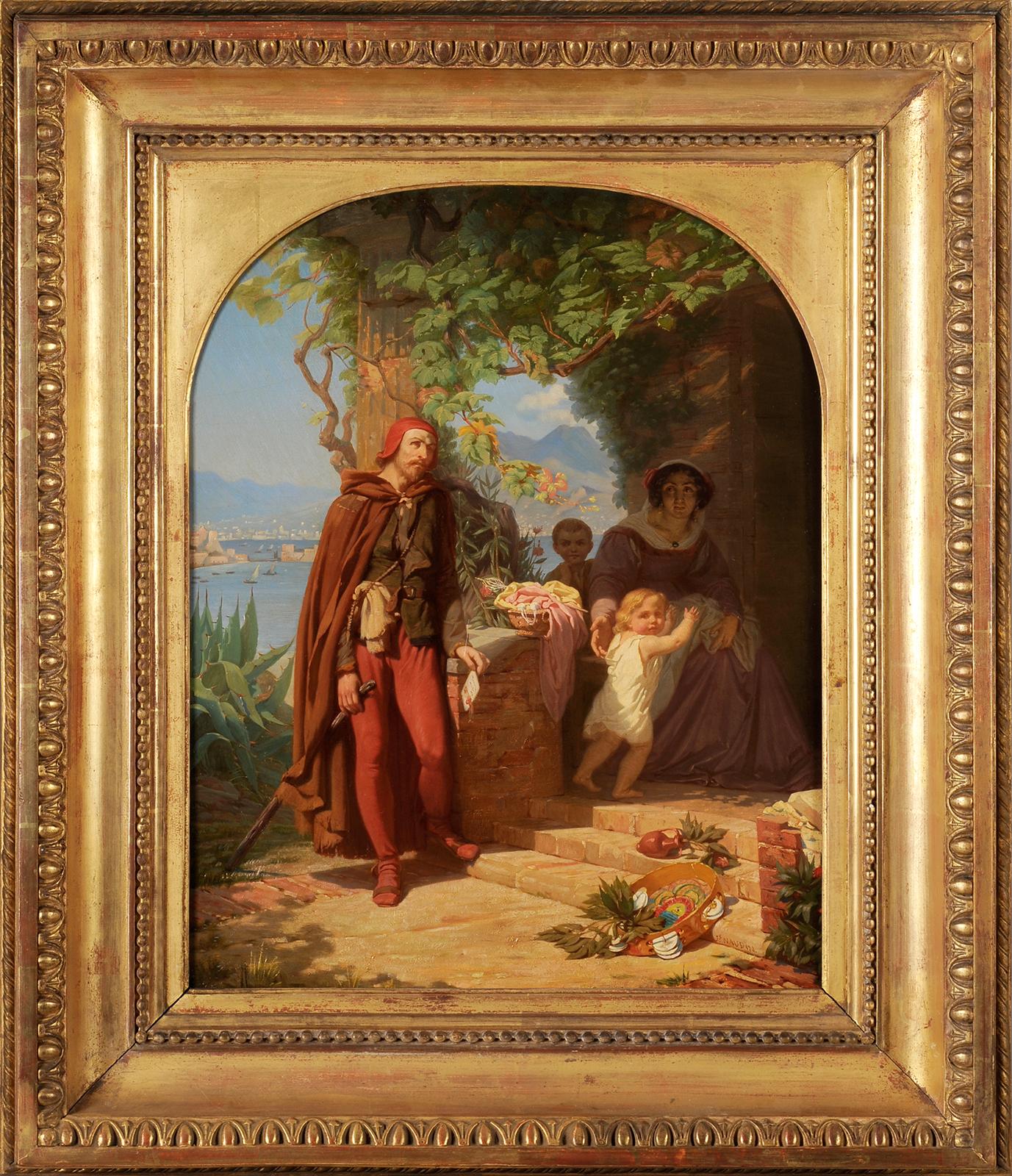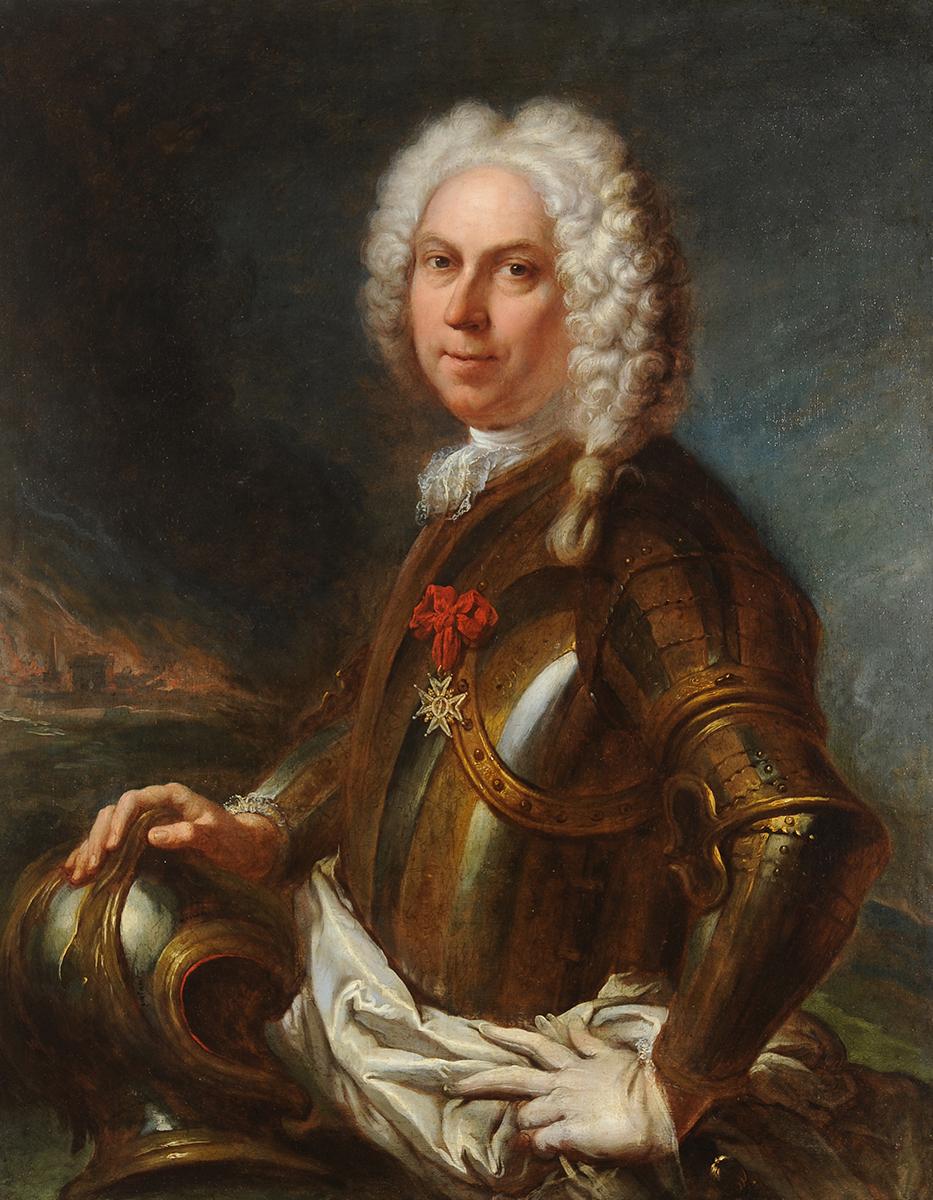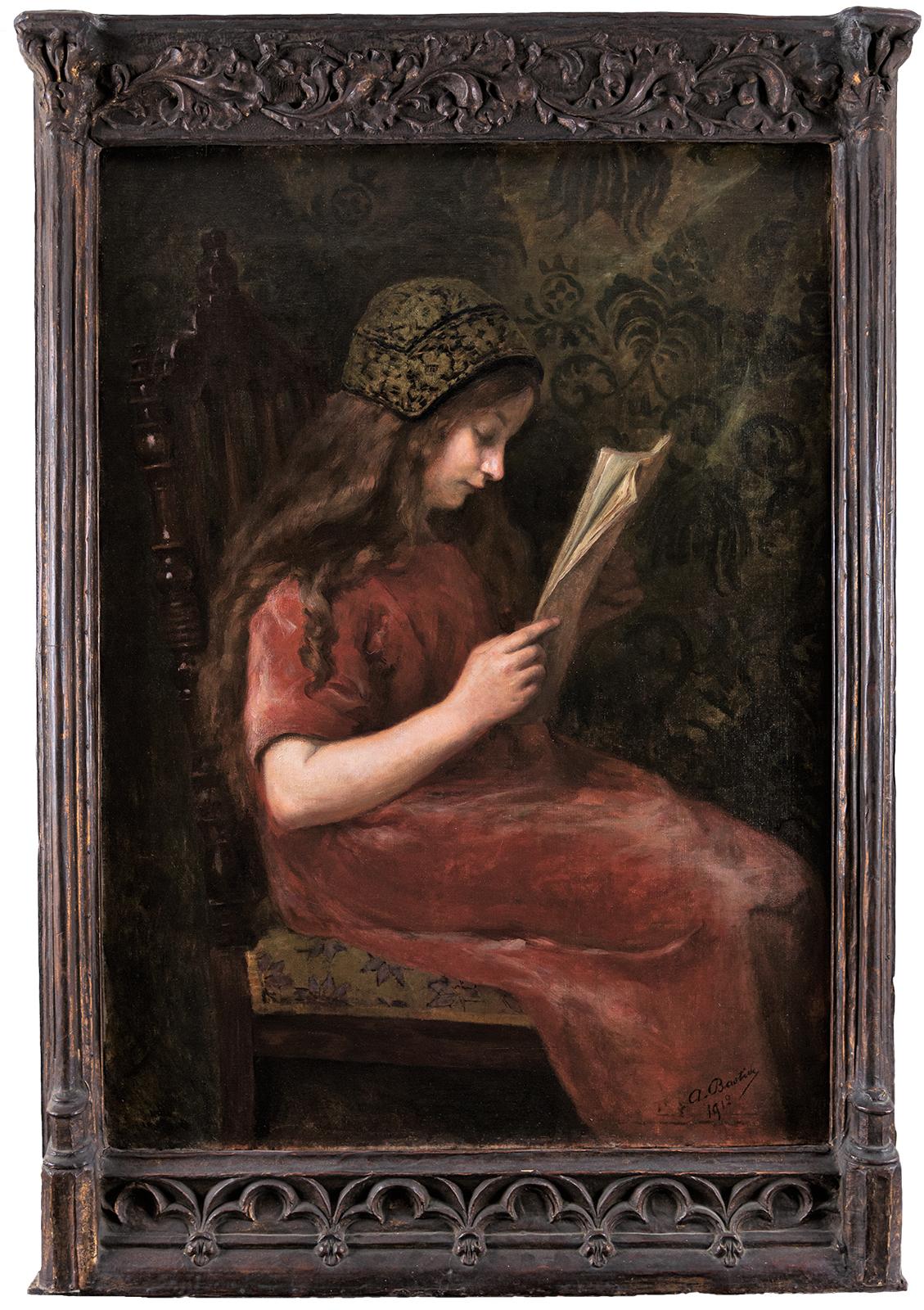Items Similar to Portrait of a woman, French Antique portrait of a woman, framed portrait
Want more images or videos?
Request additional images or videos from the seller
1 of 15
Paul Louis Léger ChardinPortrait of a woman, French Antique portrait of a woman, framed portrait1874
1874
About the Item
Antique French female portrait signed bottom right P Chardin (Paul Louis Léger Chardin 1833-1918) and dated 1874, Ville d'Avray. This delightful treasure of a painting is simple and unassuming but at the same time, very attractive. A woman, who I believe is Madame E Desaugiere sits on a large red studded chair. She looks away from the artist, deep in thought, her blue eyes complimented by a blue neck tie stored neatly under her white collar. Her arms are folded and the white cuffs of her shirt add interest.
MORE ABOUT THIS PAINTING:
Medium: Oil on stretched canvas.
Overall size: 17.5ins x 20ins or 44cms x 51cms (Approx)
Date: 1874
Signed: Paul Louis Léger Chardin (1833-1918) Paul was a painter of genre scenes, portraits, landscapes and urban landscapes.
A pupil of Dauzats and Justin Ouvrié, he exhibited at the Paris Salon between 1855 and 1875. His views of Florence, Venice, Versailles and the towns of southern Brittany are often anecdotal in character. He is noted for his Portrait of the Composer Kreutzer. His paintings are exhibited in the Victoria and Albert Museum, London.
Condition: A delightful visual piece with some imperfections such as very small areas of missing paint and darkened varnish. It sits within a gilt frame, expect missing moulding and imperfections throughout.
This painting is sent fully insured, track and trace with Colissimo.
- Creator:Paul Louis Léger Chardin (1833 - 1918, French)
- Creation Year:1874
- Dimensions:Height: 20 in (50.8 cm)Width: 17.5 in (44.45 cm)
- Medium:
- Movement & Style:
- Period:
- Condition:
- Gallery Location:AIGNAN, FR
- Reference Number:1stDibs: LU2448213684552
About the Seller
5.0
Platinum Seller
These expertly vetted sellers are 1stDibs' most experienced sellers and are rated highest by our customers.
Established in 2021
1stDibs seller since 2023
30 sales on 1stDibs
Typical response time: 1 hour
- ShippingRetrieving quote...Ships From: AIGNAN, France
- Return PolicyA return for this item may be initiated within 2 days of delivery.
More From This SellerView All
- Antique portrait of a boy, child portrait, early 1800's male framed portraitLocated in AIGNAN, FRAntique oil portrait from the early 1800's of a child in a black feather hat on a stretched canvas, framed, unsigned. This is a truly exceptional oil painting of a child, it reminds ...Category
1810s French School Portrait Paintings
MaterialsOil
- Portrait of a gentleman, 19th century portrait of a man, antique portrait manLocated in AIGNAN, FRA classic romantic portrait of a man on stretched canvas in a rectangular frame with an oval setting. This painting was found in France but is likely to be of German origin. A gent...Category
1840s Romantic Portrait Paintings
MaterialsOil
- Nude oil painting, large post-impressionist sitting nude by Pio SantiniLocated in AIGNAN, FRLarge vintage nude portrait oil painting of a woman sitting. This is a gorgeous, colourful and exceptional nude oil painting by Pio Santini, signed in the lower right. A young woman...Category
1940s Post-Impressionist Nude Paintings
MaterialsOil
- Antique portrait of a woman, French romantic oil painting, female portraitLocated in AIGNAN, FRAntique portrait of a young woman. Romantic 1800's oil painting on canvas board. This is an attractive, traditional 19th Century French oil painting in its original frame. MORE ABO...Category
1840s Romantic Portrait Paintings
MaterialsOil
- Antique portrait of a woman sitting by Carl Ernst Von StettenLocated in AIGNAN, FRLarge antique oil portrait painting of a woman sitting, signed and dated in the lower right corner, Carl V Stetten, Paris 1911. This is a beautiful large scale Art Nouveau atmospheric oil portrait by a re-known and well respected artist, Carl Ernst Von Stetten...Category
1910s Art Nouveau Portrait Paintings
MaterialsOil
- Antique figurative oil painting, Landscape, Riverscape, French artBy Pierre GarnierLocated in AIGNAN, FRAntique French landscape oil painting/figurative oil painting of a woman at the edge of the water by Pierre Garnier, signed in the bottom left...Category
1890s French School Landscape Paintings
MaterialsOil
You May Also Like
- Woman with Lobsters / "Femme et Homards"By Andre MinauxLocated in Berlin, MDAndre Minaux (French 1923 - 1986) "Femme et Homards" / Woman with Lobsters. Oil on canvas. Features a young woman holding one lobster while two others sit on a counter before her. ...Category
Mid-20th Century French School Portrait Paintings
MaterialsCotton Canvas, Oil
- Portrait of singer Adelina Patti - L. Frossard - OperaLocated in BELEYMAS, FRL. FROSSARD (active in Vienna around 1870) Portrait of Adelina Patti (1843-1919) Oil on canvas H. 100.5 cm; L. 73.5 c Signed lower left If the artist maintains a certain discretion ...Category
1860s French School Figurative Paintings
MaterialsCanvas, Oil
- Jules Naudin (1817-c.1876) - Tasso arriving at his sister's house in SorrentoBy Attilio ManganaroLocated in BELEYMAS, FRJules Ambroise Francois NAUDIN (Paris 1817 – c.1876) Tasso arriving at his sister's house in Sorrento Oil on canvas H. 49 cm; L. 37.5 cm Signed lower right Exhibition: 1852, Paris Salon, under number 959 Related work: Engraving by Jean-Denis Nargeot in 1852 Bibliography: L’Illustration, April 24, 1852, engraved by Best, Hottelin and Regnier, after a drawing by Valentin) and reproduced p.260, cited p.262; La Mode: Political, Religious and Literary Review, 1852, quoted; Journal des Demoiselles...Category
1850s French School Figurative Paintings
MaterialsCanvas, Oil
- Model undressingLocated in BELEYMAS, FRJulius EXNER (Copenhagen, 1825 - Copenhagen, 1910) Model stripping Oil on canvas H. 122 cm; L. 74 cm Signed and dated 1842 lower right Exhibition: most likely Charlottenborg Salon of 1845, under number 110, titled Modelfigur, awarded with a silver medal Provenance: Emilio Fernando Bolt (c.1860 - 1944), acquired from the artist around 1900, then by descent Our painting was produced as part of the summer sessions organized between 1839 and 1850 by Christoffer Wilhelm Eckersberg (1783-1853), the master of Danish painting of the first half of the 19th century, in his private studio-apartment on the ground floor. floor at the Royal Academy of Fine Arts in Copenhagen. The master brought together a few students there between June and September, rented one or two models for the season, which were painted from different angles, the artists (including Eckersberg himself) sitting side by side. Eckersberg used to paint a fairly small version, the pupils of the larger formats. The work fits more generally into the legendary context of the research and reforms carried out by Eckersberg concerning the studies of nudes and in particular of female nudes, to make this exercise a genre of painting in its own right. Following his two-year stint in Jacques-Louis David's studio in Paris in 1811, Eckersberg had been made aware of work on the nude and in particular on live models, in natural light, while in Denmark the drawings were then only made from casts of antique models or other mannequins. In 1822, when he had been a professor there since 1818, it was he who had the Royal Academy of Copenhagen authorize the study of nudes, no longer in the evening by candlelight, but in natural light; from 1833, it was still he who allowed students to work on nude female models, even if the official authorization of the Academy did not take place until 1839. It was this same year that he instituted his summer sessions, on a private basis, to orient his painting and that of his students towards a new conception of the representation of models: even if the nude remains the real theme, it does not however, this is more than just an academic exercise. The subject is placed in a contemporary interior, with a rather sophisticated decor, and occupied with an intimate activity (it is this type of intimate vein that we will find later in Degas or Cassatt for example); thus in our painting, the young woman is supposed to take off her clothes to wash. The objective is that the viewer forgets that the master and his students are painting a model during a posing session, and that he instead has the impression of being alone with the model, but invisible, almost like a voyeur in spite of himself. Moreover, in these paintings, the model never looks towards the spectator, inducing a psychological distance with him, whereas model and artist are actually physically very close. On the other hand, it is not a question of idealized nudes either, even if Eckersberg, proof of his debt to the antique, chooses fairly classic models and poses. The sensuality is real and very present, with dreamy, even innocent, and timeless expressions (the models do not seem to have a defined age), suave and slow attitudes and movements, and especially with clothes that hide or reveal skillfully parts of the female body: upper buttocks, pronounced hips... Made by an artist under 20, our sensual painting is probably one of the most beautiful and spectacular produced by the students of Eckersberg during these summer sessions. With a perfect balance between the firmness of an ancient statue (it recalls the Venus de Milo) and the softness of the feminine forms, highlighted by a harmonious palette, it captures the attention with many details: the almost photographic folds white clothing...Category
1840s French School Nude Paintings
MaterialsCanvas, Oil
- Portrait of a man in armorLocated in BELEYMAS, FRAttributed to Jacques DUMONT aka DUMONT LE ROMAIN (Paris 1701 - 1781) Presumed portrait of Louis-Joseph de Formanoir (?-1732) Oil on canvas H. 91.5 cm; ...Category
1750s French School Figurative Paintings
MaterialsCanvas, Oil
- Young girl readingLocated in BELEYMAS, FRAlice BASTIDE (Saint Mandé 1868 – Paris 1959) Portrait of a little girl reading Oil on canvas H. 100 cm; L. 72.5 cm Signed lower right and dated 1912 Daughter of a pastor from Gard and an English woman, Alice Bastide grew up in Paris. A pupil of the Jullian Academy, she began her apprenticeship under the guidance of Henri Royer and François Schommer. The development of his art is mainly oriented towards still lifes, without completely abandoning portraits and landscapes. Her other specialty for which she received numerous awards is miniatures. At the Salon of 1914 she received the Maxime David prize crowning the best piece while her finesse was already noticed by press critics from 1907. Coronation, in 1926 she received a gold medal at the Salon for her miniature Coquetterie. In 1896, the young woman married a man from Gard, Auguste Massebiaux, whose name she would occasionally bear. The latter, a lawyer at the Paris Court of Appeal, died in 1910. The couple had no children. At that time she was domiciled at 48 avenue d'Orléans (later named avenue du general Leclerc) in Paris where she lived until her death in 1959. Until the mid-1930s she continued to exhibit at the Salon des Artistes French with a manner very close to Impressionism, luminous and vigorous. In 1912, two years after the death of her husband, Alice Bastide was certainly still marked by the sadness of her mourning. The tones of our portrait of a little girl and the frame she puts together are dark and heavy. This child, wearing an embroidered bonnet, is bent over her book, her loose hair flowing over a red velvet indoor dress. This intimate portrait on a dark tapestry...Category
1910s French School Figurative Paintings
MaterialsOil, Canvas





